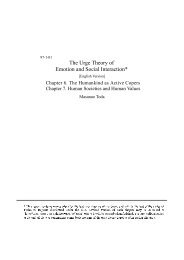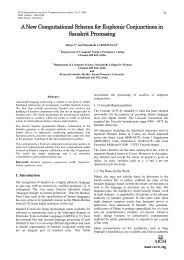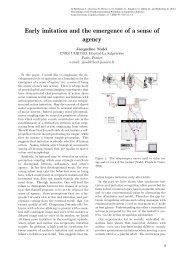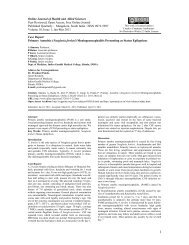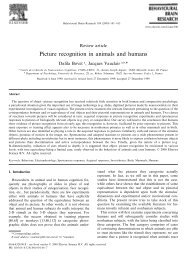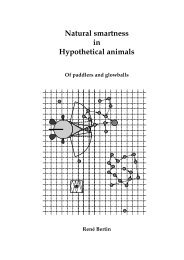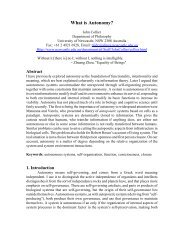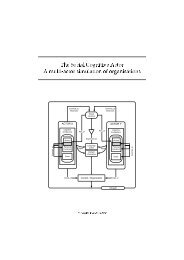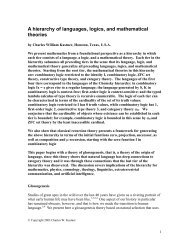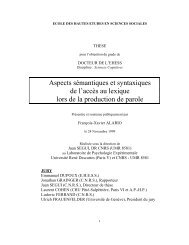Development of a Hindi Lemmatizer - arXiv
Development of a Hindi Lemmatizer - arXiv
Development of a Hindi Lemmatizer - arXiv
You also want an ePaper? Increase the reach of your titles
YUMPU automatically turns print PDFs into web optimized ePapers that Google loves.
International Journal <strong>of</strong> Computational Linguistics and Natural Language Processing Vol 2 Issue 5 May 2013<br />
ISSN 2279 – 0756<br />
tool. He used supervised approach by creating a SVM<br />
classifier. Jena et al. [6] proposed a morphological analyzer<br />
for Oriya language by using the paradigm approach. They<br />
classified nouns, adjectives and finite verbs <strong>of</strong> Oriya by using<br />
various paradigm tables. Anand Kumar et al. [4] developed an<br />
automatic system for the analysis <strong>of</strong> Tamil morphology. They<br />
used various methodologies, rule based approach and<br />
sequence labelling containing the non linear relationships <strong>of</strong><br />
morphological features from the training data in a better way.<br />
Chachoo et al. [3] used an extract tool named Extract v2.0<br />
for the development <strong>of</strong> the orthographic component <strong>of</strong><br />
Kashmiri Script. A method has been proposed by Majumder et<br />
al. [9] in which a clustering based approach is used for<br />
discovering the equivalent classes <strong>of</strong> root words. This<br />
algorithm was tested for two languages French and Bangla. A<br />
rule based approach for stemming in <strong>Hindi</strong> was proposed by<br />
Ramanathan & Rao [8]. The approach is based on stripping<br />
<strong>of</strong>f suffixes by generating rules emphasizing on noun,<br />
adjective and verb inflections in <strong>Hindi</strong>. Bharti Akshar et al. [2]<br />
proposed the work on natural language processing where they<br />
gave a detailed study <strong>of</strong> morphology using paradigm approach.<br />
Gupta et al. [13] proposed unsupervised approach for<br />
stemming where they have used partial lemmatization along<br />
with some database. They aimed to improve unsupervised<br />
stemming by removing over-stemming problem. Mohd.<br />
Shahid Husain [14] developed a stemmer by using<br />
unsupervised approach. He used two different approaches<br />
frequency based and length based method for suffix stripping<br />
where he used Emille corpus for Urdu and Marathi languages.<br />
III. LINGUISTIC BACKGROUND OF HINDI<br />
Morphemes play a major role in morphology. This is the<br />
major way in which morphologists investigate words, then<br />
internal structure and their formation. Morphology is broadly<br />
categorized into two parts: derivational morphology and<br />
inflectional morphology. Derivational morphology processes<br />
the words and form new lexemes from the existing ones. This<br />
is done by either adding or deleting affixes. For example –<br />
सचा + ई = सचाई. The class <strong>of</strong> the word is changed from<br />
adjective to noun. Similarly, in English we have words like<br />
computer + ization = computerization, where the class is<br />
changed from noun to adjective. Inflectional morphology<br />
processes the words by producing various inflections without<br />
changing the word class. For example – कताब + ◌े◌ं = कताब<br />
where कताब is noun/singular while कताब is noun/plural.<br />
The class remains same here. The root form <strong>of</strong> the words<br />
basically comes under noun and verb classes. This knowledge<br />
lead us to trace the paradigm approach. According to Smriti<br />
Singh and Vaijayanthi M Sarma [7], <strong>Hindi</strong> noun classification<br />
system shows only the number and case for morphological<br />
analysis. Number basically includes either singular or plural.<br />
By default we keep the number <strong>of</strong> a word as singular. Case on<br />
<strong>Hindi</strong> words is <strong>of</strong> two types – direct and oblique. Oblique<br />
words show the case as well as the number <strong>of</strong> the word. For<br />
example – लड़क – ◌ा, लड़क – ◌े, here ◌ा shows singular<br />
number whereas ◌े shows plural number. Similarly we also<br />
have some gender rules. In <strong>Hindi</strong>, words that end with the<br />
suffix ◌ी are marked feminine whereas the words that end<br />
with suffix ◌ा are marked as masculine. For example लड़का is<br />
masculine ending with ◌ा while लड़क is feminine ending with<br />
◌ी. But there are many words that contradict this concept. For<br />
example – we have the word पानी (water) which is masculine<br />
although it is ending with ◌ी. Similarly we have another word<br />
माला (garland) which is feminine even though ending with ◌ा.<br />
There are also some words which has the suffix that cannot be<br />
removed. For example – let us consider the suffix ◌ा, the<br />
words पता, माता, बचा, कटोरा, नेता, and many more does not<br />
require stemming. Such words need to be maintained as it is<br />
and should be refrained from being stemmed. So we find that<br />
<strong>Hindi</strong> is a highly inflected language which needs the deep<br />
study <strong>of</strong> word structure and its formation.<br />
IV. PROPOSED WORK<br />
In this paper we have discussed about the creation <strong>of</strong> a<br />
<strong>Hindi</strong> lemmatizer. Our approach is based on the key concept<br />
<strong>of</strong> optimization. Optimization includes both space and time, so<br />
our approach is based on these parameters. The lemmatizer<br />
that we discuss here mainly focuses on the time complexity.<br />
Typically a lemmatizer is built using rule based approach. In<br />
rule based approach along with the rules, knowledgebase is<br />
created for storing the grammatical features. Although the<br />
knowledgebase creation requires a large amount <strong>of</strong> memory,<br />
but in respect <strong>of</strong> time it gives us the best, accurate and fast<br />
result. The reason behind this fast retrieval is that, a very short<br />
time is taken to search the input word from the knowledgebase.<br />
A study has been conducted in Tamil which shows that Tamil<br />
words have infinite set <strong>of</strong> inflections but <strong>Hindi</strong> words have<br />
finite set <strong>of</strong> inflections which are quite easy to maintain in the<br />
knowledgebase. We have restricted our knowledgebase to<br />
commonly used words which do not contain the proper nouns<br />
like the names <strong>of</strong> person and place.<br />
A. Approach Used<br />
Although there are many approaches for performing<br />
lemmatization like supervised approach, rule based approach,<br />
unsupervised approach, but among these approaches rule<br />
based approach is one <strong>of</strong> the most acceptable approach. We<br />
have used rule based approach for extracting the suffixes. In<br />
rule based approach we have created many different rules for<br />
eliminating the suffixes. Since rule based approach totally<br />
works according to the rules therefore there is a less chance <strong>of</strong><br />
error in obtaining the output. Rule based approach also<br />
optimizes the work by which we can get the result in a blink<br />
<strong>of</strong> an eye.<br />
B. Suffix Generation<br />
For the development <strong>of</strong> a lemmatizer we have gone<br />
through various words with their suffixes and examined the<br />
Snigdha Paul et.al.<br />
381<br />
www.ijclnlp.org



